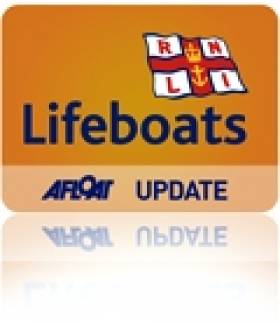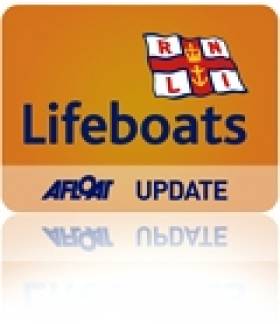Displaying items by tag: RNLI lifeboat
Donaghadee RNLI Crew Members to Receive Awards
Seven lifeboat Crew Members from Donaghadee RNLI lifeboat station are to be recognised by the Royal National Lifeboat Institution for their part in an early morning rescue that took place in horrendous weather conditions and resulted in three lives being saved.
The callout happened just after 2am on the morning of 13 September 2009, when the yacht Bentim Buoys with three crew onboard was on passage from the Isle of Man to Bangor and ran aground.
Coxswain Philip McNamara is to be accorded the Thanks of the Institution on Vellum while Deputy Second Coxswain John Ashwood, Mechanic Shane McNamara, Crew Members Stephen McComiskey, David McCormack, Richard McGimpsey, and John Petrie will each receive a Vellum Service Certificate. The Vellum award from the RNLI is for services that show great skill and expertise by the lifeboat crew, often carried out in very difficult condition.
The service lasted just under four hours but in that time the lifeboat crew had to deal with deteriorating weather conditions, which were battering the lifeboat and the grounded vessel. They also had to plan and put into practice several attempts to bring the crew and the vessel to the safety of Donaghadee harbour when the worsening seas prevented the standard rescue procedures.
At 2.15 am on the morning of 13 September 2009 the lifeboat crew’s pagers were activated to go to the aid of a 10 metre yacht which had run aground on Craig Brain Rocks. En route to the scene the lifeboat met with poor weather conditions. Once exposed to open water the wind was force 5 with the swell reaching 2 metres and worsening. As the lifeboat crew approached the yacht they could see it was in imminent danger of breaking up.
Lifeboat Coxswain Philip McNamara used great skill in manoeuvring the lifeboat in difficult seas. Two lifeboat crew launched a small craft from the lifeboat, which allows close access to the shore. From that Richard McGimpsey and David McCormack attempted to board the vessel but they were swept out into the sea and had to return to the lifeboat using paddles. The crew on the casualty vessel were unable to leave their yacht and so the decision was taken by the Coxswain to attempt to establish a tow and drag the yacht off the rocks, hoping that the vessel would float.
Several attempts were made to establish a line from the lifeboat to the yacht, which were severely hampered by the weather. Finally at 3.30am a line was established and secured onto the yacht. The vessel started to come upright but the line parted. Lifeboat Mechanic Shane McNamara had prepared a second towline and finally at 3.39am the yacht came upright, moved along the rocks and refloated. However the tow then parted and the yacht was cast adrift and in great danger of grounding a second time.
The lifeboat crew reacted immediately and recovered the towline. The Coxswain once again manoeuvred the lifeboat close to the yacht and the tow was re-established. The yacht and her three shaken crew were then taken back to Donaghadee with no serious injuries.
Commenting on the service RNLI Divisional Inspector for Ireland Martyn Smith said, ‘These vellums are well deserved for what was an extraordinary service, resulting in three lives being saved. Split second decisions were made by the Coxswain in horrendous conditions. The lifeboat crew were operating in an area where local knowledge was vital and they used this to great effect. The Coxswain also had to manoeuvre the lifeboat very carefully, as the lifeboat crew attempted to bring the yacht and her crew to safety.
‘This all happened in the middle of the night and under very challenging conditions. With the lifeboat rolling in heavy seas various scenarios and options were worked out by the crew, which ultimately ensured the safe recovery of the three men and their yacht. I want to pay tribute to the lifeboat crew lead by Coxswain Philip McNamara for this incredible service.”
The presentation of the awards to the lifeboat crew will be made later in the year.
Family of an Irish fisherman became concerned when his 14 metre fishing vessel failed to return to harbour at 23:30. Attempts were made to contact the fisherman by radio and phone but to no avail. Ballycotton RNLI lifeboat station was contacted at 01:00 and the crew pagers were activated.
The Ballycotton RNLI lifeboat, Austin Lidbury, was given the last known position of the fishing vessel and they proceeded to the area 8 miles south east of Ballycotton lighthouse. The Waterford based Coastguard helicopter, Rescue 117, was also launched. When close to the vessel’s last known position a red flare was spotted by the Ballycotton lifeboat and the fisherman was found safe and well in a life raft. It is understood he had been in the life raft for approx. four hours. He was taken aboard the RNLI lifeboat where his condition was assessed. He was safely landed ashore in Ballycotton where his family awaited his return.
Cruise ship drama ends safely
A request from the MV Oriana via the Irish Coastguard's MRCC Dublin (Marine Rescue Co-Ordination Centre) was made for the man who had taken ill around mid-night and was being treated by a ship's doctor.
Dun Laoghaire's All-weather lifeboat was tasked under Cox'n Ken Robertson with a volunteer crew including Dr. Sarah Brookes and launched at 4.20am to meet the 6,000-tonne cruise ship on Dublin Bay.
Dun Laoghaire's lifeboat station is online, with regular updates coming from their Facebook Page.






























































